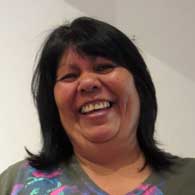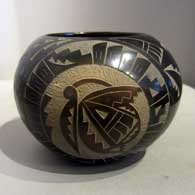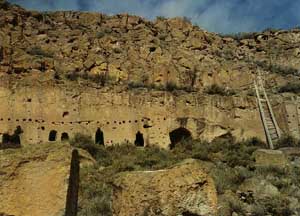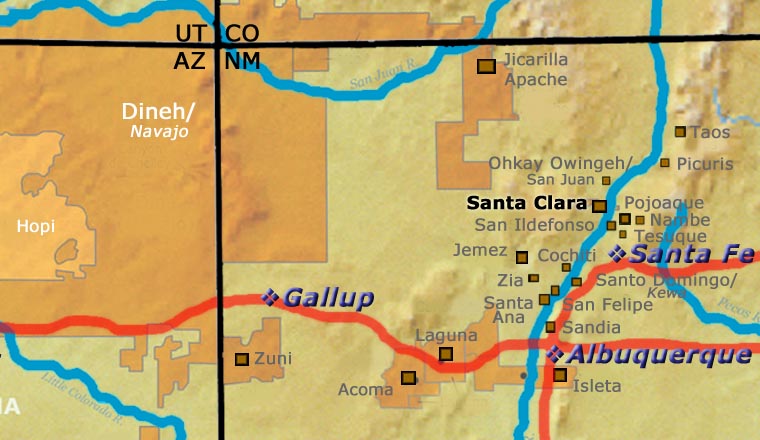
Candelaria Suazo
Santa Clara/
San Juan


Candelaria Suazo was born to Joe and Santanita Suazo of Santa Clara and San Juan Pueblos. She has been making pottery since she was 20 years old. Among her teachers and those who still inspire her are her mother and her sisters: Margie Naranjo, Martha Haungooah, Mae Tapia and Shirley Duran. Relatives Dolores Curran and Geri Naranjo also had a great influence on her work over the years.
Making pueblo pottery is a complex and time consuming occupation. The most critical moments are mixing the clay at the beginning preparations and in the last step, which is firing the finished pot outdoors. Candelaria digs and mixes her own clay, then coils and shpes her pots by hand. No glazes are used, only a stone to polish the raw surface. The pot is fired outdoors in a traditional firing pit using "cow patties" and dried horse manure. To obtain a black finish, a reduction process is employed where the pots are smothered with a mix of ashes and pulverized manure.
Candelaria tells us her favorite shapes to work with include miniature bowls and vases. The sgraffito (etched) style that she specializes in is accomplished after the “smothering” process that turns the pottery black. A figure such as a finely etched “avanyu” (water serpent) will surround the entire pot. Often kiva steps and cloud designs will complete the work. Other favored designs are butterflies and/or hummingbirds that are intricately carved on opposite sides of a piece. She also uses a special technique that highlights part of a pot by reheating a section of the pot and changing its color.
Candelaria says, “I enjoy making pottery because I want to keep up the traditional art of pottery making that the pueblo of Santa Clara is known for.” She exhibits at the Eight Northern Pueblos Arts and Crafts Show and has won several ribbons for First, Second and Third Places. She signs her work: “Candelaria Suazo, Santa Clara Pueblo.”
100 West San Francisco Street, Santa Fe, New Mexico 87501
(505) 986-1234 - www.andreafisherpottery.com - All Rights Reserved

Santa Clara Pueblo

Ruins at Puye Cliffs, Santa Clara Pueblo
Santa Clara Pueblo straddles the Rio Grande about 25 miles north of Santa Fe. Of all the pueblos, Santa Clara has the largest number of potters.
The ancestral roots of the Santa Clara people have been traced to ancient pueblos in the Mesa Verde region in southwestern Colorado. When that area began to get dry between about 1100 and 1300 CE, some of the people migrated eastward, then south into the Chama River Valley where they constructed several pueblos over the years. One was Poshuouinge, built about 3 miles south of what is now Abiquiu on the edge of the Jemez foothills above the Chama River. Eventually reaching two and three stories high, and with up to 700 rooms on the ground floor, Poshuouinge was occupied from about 1375 CE to about 1475. Drought then again forced the people to move, some of them going to the area of Puye (on the eastern slopes of the Pajarito Plateau of the Jemez Mountains) and others downstream to Ohkay Owingeh (San Juan Pueblo, along the Rio Grande). Beginning around 1580 CE, drought forced the residents of the Puye area to relocate closer to the Rio Grande and they founded what we now know as Santa Clara Pueblo on the west bank of the river, with San Juan Pueblo to the north and San Ildefonso Pueblo to the south.
In 1598 the seat of Spanish government was established at Yunque, near San Juan Pueblo. The Spanish proceeded to antagonize the Puebloans so badly that that government was moved to Santa Fe in 1610, for their own safety.
Spanish colonists brought the first missionaries to Santa Clara in 1598. Among the many things they forced on the people, those missionaries forced the construction of the first mission church around 1622. However, like the other pueblos, the Santa Clarans chafed under the weight of Spanish rule. As a result, they were in the forefront of the Pueblo Revolt of 1680. One Santa Clara resident, a mixed black and Tewa man named Domingo Naranjo, was one of the rebellion's ringleaders. However, the pueblo unity that allowed them to chase the Spanish out fell apart shortly after their success, especially after Popé died.
When Don Diego de Vargas came back to the area in 1694, he found most of the Santa Clarans on top of nearby Black Mesa (with the people of San Ildefonso). A six-month siege didn't subdue them so finally, the two sides negotiated a treaty and the people returned to their pueblos. However, successive invasions and occupations by northern Europeans took their toll on all the tribes over the next 250 years. Then the swine flu pandemic in 1918 almost wiped them out.
Today, Santa Clara Pueblo is home to as many as 2,600 people and they comprise probably the largest per capita number of artists of any North American tribe (estimates of the number of potters run as high as 1-in-4 residents).
Today's pottery from Santa Clara is typically either black or red. It is usually highly polished and designs might be deeply carved or etched ("sgraffito") into the pot's surface. The water serpent, (avanyu), is a very common traditional design motif on Santa Clara pottery. Another motif comes from the legend that a bear helped the people find water during a drought. The bear paw has appeared on much of their pottery ever since.
Santa Clara has received a lot of distinction because of the evolving artistry the potters have brought to their craft. Not only did this pueblo produce excellent black and redware, several notable innovations helped move pottery from the realm of utilitarian vessels into the domain of art. Different styles of polychrome redware emerged in the 1920s-1930s. In the early 1960s experiments with stone inlay, incising and double firing began. Modern potters have also extended the tradition with unusual shapes, slips and designs, illustrating what one Santa Clara potter said: "At Santa Clara, being non-traditional is the tradition." (This refers strictly to artistic expression; the method of creating pottery remains traditional).
Santa Clara Pueblo is home to a number of famous pottery families: Tafoya, Baca, Gutierrez, Naranjo, Suazo, Chavarria, Garcia, Vigil, and Tapia - to name a few.
100 West San Francisco Street, Santa Fe, New Mexico 87501
(505) 986-1234 - www.andreafisherpottery.com - All Rights Reserved


